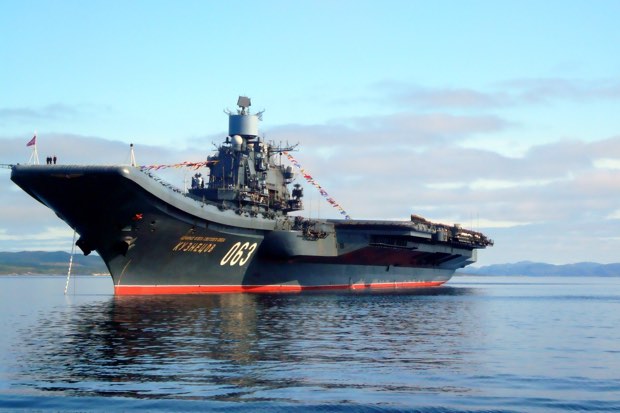As the Russian aircraft carrier Admiral Kuznetsov finally nears the eastern Mediterranean, with a trail of ugly black smoke belching from its funnels, it’s a fitting moment to acknowledge some credit where it’s due.
For the waves created by President Putin’s flagship as it passed our shores – before steaming into further controversy in Spain – more than endorse the Cameron government’s brave decision to press on with Britain’s new £3 billion aircraft carrier, the HMS Queen Elizabeth, in the aftermath of the 2008 financial crisis.
For it was the Cameron government’s decision – in that otherwise largely unloved strategic defence review (the one that saw the abrupt consignment of the HMS Ark Royal to the scrapyard and the sale of Harrier) – to commit to the completion of the Queen Elizabeth as well as her sister ship, the Prince of Wales back in 2010. We then had to wait until 2014 before the government committed to the future deployment of both carriers, removing the crackpot prospect of one of them being mothballed on completion.
As ever, the decisions about Queen Elizabeth and Prince of Wales were accompanied by grumbles from those who queried their north-of-£5 billion cost (that’s without the aircraft, of course) or their military justification in the modern world. However, whatever critics of large aircraft carriers may say (some argue that they’re now merely floating targets for ever-advancing missiles technology and will last all of 24 hours in a future war), the recent voyage of the Kuznetsov shows that carriers do matter.
When I interviewed Captain Jerry Kyd, the new commander of HMS Queen Elizabeth aboard the ship this summer, he made the point to me that when these vessels were moved they would create noise – and not just with their engines. He said our new carriers would be ‘strategic weapons’ and used as such. Russia’s deployment of the Admiral Kuznetsov to the Mediterranean proves he is right. Carriers, even ones as reportedly decrepit as the Soviet-built Kuznetsov, generate a lot of interest. And the really good news is that our new carrier is almost twice the size of the Kuznetsov, and when loaded with 24 fifth generation F35B Lightning IIs, she promises to be far more powerful than the Kuznetsov – and we’ll have two of them.
The bad news is that we have to wait until 2018 for the first of the carriers to come on stream, and then without her F35Bs (they won’t arrive until 2020). But even if our F35Bs aren’t ready in time, then those flown by the US Marine Corps will be able to land and take off from her, which is worth thinking about. Of course, 2018 will be here soon enough. It also happens to be the year that Putin is expected to stand for re-election, which is another reason to celebrate the timely arrival of Britain’s more advanced carriers. I know – perish the thought. But it’s always better to perish the thought from a position of strength.






Comments